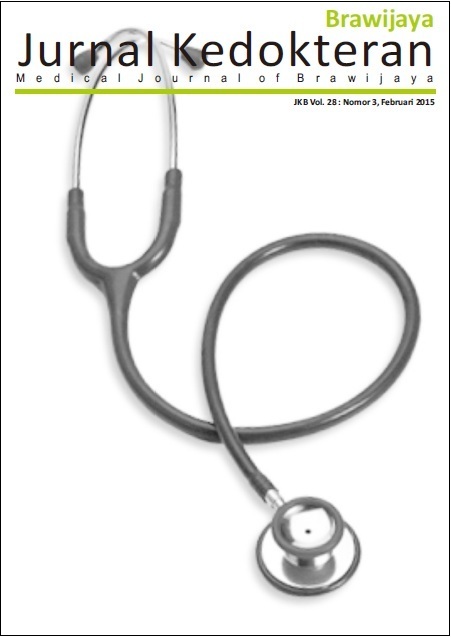Uji Diagnostik Indeks Darah dan Identifikasi Molekuler Karier Talasemia β pada Pendonor Darah di Banyumas
DOI:
https://doi.org/10.21776/ub.jkb.2015.028.03.13Abstract
Talasemia menempati kelainan genetik yang paling umum di seluruh dunia dengan prevalensi karier talasemia di Indonesia adalah sekitar 3-10%. Banyumas merupakan salah satu wilayah yang menyumbang angka prevalensi penderita talasemia yang cukup besar. Salah satu perangkat dalam program pencegahan terpadu adalah memastikan diagnosa molekuler pada tahap skrining sesuai dengan mutasi lokal. Tujuan dari penelitian adalah untuk mengetahui nilai uji diagnostik indeks darah dan karakterisitik mutasi talasemia β pada pendonor darah yang dicurigai karier talasemia. Subjek penelitian adalah 183 pendonor darah rutin pada PMI Banyumas. Skrining awal menggunakan indeks darah MCV, MCH, dan Hemoglobin elektroforesis. Karakteristik molekuler dilakukan dengan teknik PCR-RFLP dan teknik ARMS.  Hasil penelitian menunjukkan bahwa MCV memiliki nilai sensitivitas 81,3%, dan spesifisitas 95,8% sedangkan MCH menunjukkan sensitivitas sebesar 80% dengan spesifisitas 97,5%. Mutasi IVS-1 nt 5 (G>C) merupakan mutasi tersering disusul dengan HBE (codon 26) dan IVS1 nt 1(G>T).
Kata Kunci: Identifikasi molekuler, indeks darah, karier talasemia
Downloads
References
Weatherall DJ. Thalassemi as a Global Health Problem: Recent Progress Toward its Control in the Developing Countries. Annals of the New York Academy of Sciences. 2010; 1202(1): 17-23.
Sofro AS. Molecular Pathology of Beta-Talasemia in Indonesia. The Southeast Asian Journal of Tropical Medicine and Public Health. 1995: 26 (Suppl1): 221-224.
Lanni F, Gani RA, Widuri, Rochdiyat W, Verawaty B, Sukmawati, dkk. β-Thalassemia and Hemoglobin-E traits in Yogyakarta Population. Dipresentasikan pada 11th International Conference on Thalassaemia and Haemoglobinophaties & 13rd International TIF Conference for Thalassaemia Patients and Parents. Singapore; 8-11 Oktober 2008
Rujito L, Setyono J, dan Siswandari W. Data Penelitian Project Riset Unggulan Unsoed (RUKU) 2012. [Laporan]. Universitas Jenderal Soedirman, Purwokerto. 2012.
Weatherall DJ. Fortnightly Review: The Thalassaemias. British Medical Journal. 1997; 314(7095): 1675.
Sin SY, Ghosh A, Tang LC, and Chan V. Ten Years Experience of Antenatal Mean Corpuscular Volume Screening and Prenatal Diagnosis for Talasemia in Hongkong. Journal of Obstetrics and Gynaecology Research. 2000; 26(3): 203-208.
Health Technology Assesment. Pencegahan Talasemia (Hasil Kajian HTA tahun 2009). Jakarta: Dirjen Bina Pelayanan Medik Kementerian Kesehatan Republik Indonesia; 2010.
Centers for Disease Contol and Prevention. Thalassemia. (Online). http://www.cdc.gov/ncbddd/ talasemia/indeks.html.
Li LY, Li Q, Song LL, et al. The value of MCV, MCH and HbA(2) in Laboratory Screening of Thalassemia. Zhonghua Fu Chan Ke Za Zhi. 2012; 47(2): 96-100.
Buckingham L. Molecular Diagnostics: Fundamentals, Methods and Clinical Applications. 2nd edition. Canada: FA Davis Company; 2011.
Mahadik CT. Experience With Multiplex ARMS (MARMS)-PCR for the Detection of Common Beta-Thalassemia Mutations in India. Cardiovascular & Hematological Agents in Medicinal Chemistry. 2012; 10(1): 14-24.
Hernanda PY, Tursilowati L, Arkesteijn SG, et al. Towards a Prevention Program for Beta-Talasemia. The Molecular Spectrum in East Java, Indonesia. Hemoglobin. 2012; 36(1): 1-6.
Harteveld CL and Higgs DR. Alpha-Thalassaemia. Orphanet Journal of Rare Diseases. 2010; 5(1): 13.
Muncie HR and Campbell JS. Alpha and Beta Thalassemia. American Family Physician. 2009; 80(4): 339-344.
Shen C, Jiang YM, Shi H, et al. Evaluation of Indices in Differentiation between Iron Deficiency Anemia and Beta-Talasemia Trait for Chinese Children. Journal of Pediatric Hematology/Oncology. 2010; 32(6): 218-222.
Yong KN, Wadsworth D, Langlois S, Yong SL, and Wilson RD. Talasemia Carrier Screening and Prenatal Diagnosis among the British Columbia (Canada) Population of Chinese Descent. Clinical Genetics. 1999; 55(1): 20-25.
Weatherall DJ and JB Clegg. The Thalassaemia Syndromes. 4th edition. Oxford: Blackwell Science; 2008.
Weatherall DJ. Phenotype-Genotype Relationships in Monogenic Disease: Lessons from the Thalassaemias. Nature Reviews Genetics. 2001; 2(4): 245-55.
Vehapoglu A, Ozgurhan G, Demir AD, et al. Hematological Indices for Differential Diagnosis of Beta Thalassemia Trait and Iron Deficiency Anemia. Anemia. 2014; 2014: 7.
Dell'edera D, Epifania AA, Milazzo GN, et al. Identification of Patients with Defects in the Globin Genes. Journal of Prenatal Medicine. 2013; 7(4): 47-50.
Singh SP and Gupta S. Molecular Pathogenesis and Clinical Variability of Homozygous Beta 0-Thalassemia in Populations of Jammu Region of J&K State (India). Hematology. 2006; 11(4): 271-275.
Pramoonjago P, Harahap A , Taufani RA, Setianingsih I, Marzuki S, and Harahap A. Rapid Screening for the Most Common a Thalassaemia Mutations in South East Asia by PCR Based Restriction Fragment Length Polymorphism Analysis (PCR-RFLP). Journal of Medical Genetics. 1999; 36(12): 927-938
Downloads
Published
Issue
Section
License
Authors who publish with this journal agree to the following terms:- Authors retain copyright and grant the journal right of first publication with the work simultaneously licensed under a Creative Commons Attribution License that allows others to share the work with an acknowledgement of the work's authorship and initial publication in this journal.
- Authors are able to enter into separate, additional contractual arrangements for the non-exclusive distribution of the journal's published version of the work (e.g., post it to an institutional repository or publish it in a book), with an acknowledgement of its initial publication in this journal.
- Authors are permitted and encouraged to post their work online (e.g., in institutional repositories or on their website) prior to and during the submission process, as it can lead to productive exchanges, as well as earlier and greater citation of published work (See The Effect of Open Access).














